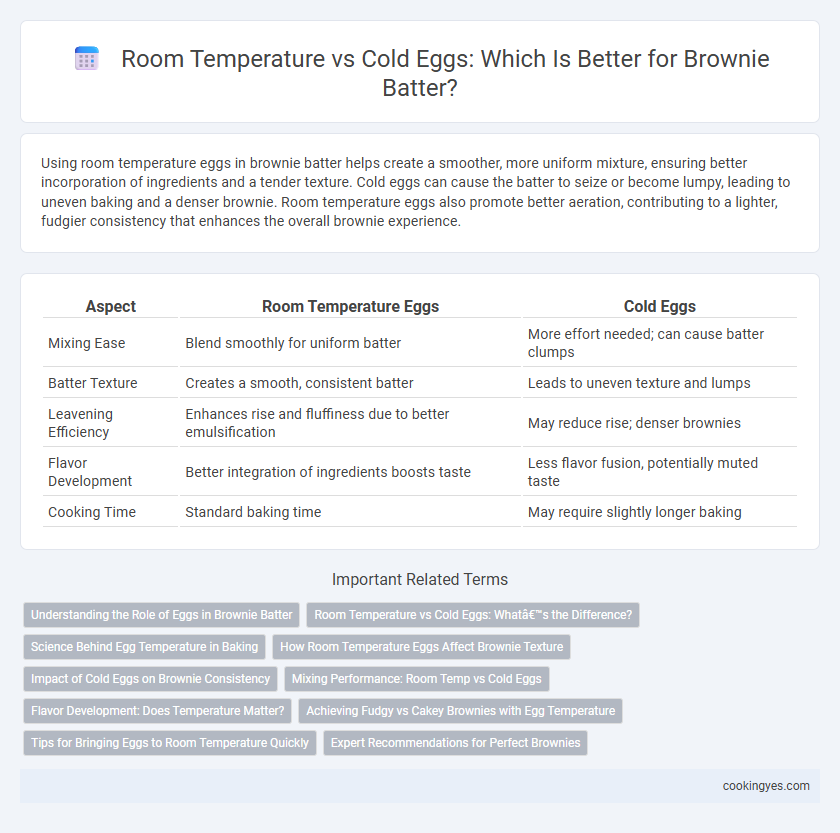Using room temperature eggs in brownie batter helps create a smoother, more uniform mixture, ensuring better incorporation of ingredients and a tender texture. Cold eggs can cause the batter to seize or become lumpy, leading to uneven baking and a denser brownie. Room temperature eggs also promote better aeration, contributing to a lighter, fudgier consistency that enhances the overall brownie experience.
Table of Comparison
| Aspect | Room Temperature Eggs | Cold Eggs |
|---|---|---|
| Mixing Ease | Blend smoothly for uniform batter | More effort needed; can cause batter clumps |
| Batter Texture | Creates a smooth, consistent batter | Leads to uneven texture and lumps |
| Leavening Efficiency | Enhances rise and fluffiness due to better emulsification | May reduce rise; denser brownies |
| Flavor Development | Better integration of ingredients boosts taste | Less flavor fusion, potentially muted taste |
| Cooking Time | Standard baking time | May require slightly longer baking |
Understanding the Role of Eggs in Brownie Batter
Eggs play a crucial role in brownie batter by providing structure, moisture, and richness, which influence the final texture and taste. Using room temperature eggs helps them integrate more smoothly with other ingredients, creating a uniform batter that rises evenly and results in a tender crumb. Cold eggs can cause uneven mixing, leading to a denser, less consistent brownie texture.
Room Temperature vs Cold Eggs: What’s the Difference?
Using room temperature eggs in brownie batter ensures better emulsification, resulting in a smoother, more consistent texture and improved rise. Cold eggs can cause the batter to seize or curdle, leading to uneven mixing and denser brownies. Room temperature eggs blend more easily with melted butter and sugar, enhancing the overall moisture and fudginess of the final product.
Science Behind Egg Temperature in Baking
Egg temperature significantly impacts the texture and structure of brownie batter due to the science of protein denaturation and fat emulsification. Room temperature eggs blend more easily with sugar and fats, creating a smoother, more homogeneous batter that traps air, leading to better rise and a tender crumb. Cold eggs slow down these chemical reactions, potentially causing uneven mixing and denser brownies with less optimal texture.
How Room Temperature Eggs Affect Brownie Texture
Using room temperature eggs in brownie batter improves emulsification with fats, resulting in a smoother, more uniform texture. This enhances the batter's ability to trap air, contributing to a tender and moist crumb. Cold eggs can cause uneven mixing and denser brownies due to reduced fat integration.
Impact of Cold Eggs on Brownie Consistency
Cold eggs in brownie batter cause uneven mixing, leading to a denser and less uniform texture. The sudden temperature drop can cause melted butter or chocolate to seize, resulting in clumps and inconsistent batter consistency. Room temperature eggs blend smoothly, promoting a tender crumb and even baking throughout the brownies.
Mixing Performance: Room Temp vs Cold Eggs
Room temperature eggs blend more smoothly into brownie batter, promoting even mixing and consistent texture by emulsifying fats and liquids effectively. Cold eggs can cause the batter to seize or become lumpy, leading to uneven baking and denser brownies. Optimal mixing with room temperature eggs yields a richer, fudgier crumb and improves overall brownie quality.
Flavor Development: Does Temperature Matter?
Room temperature eggs blend more evenly into brownie batter, promoting better emulsification and enhancing the overall texture and flavor. Cold eggs can cause uneven mixing, leading to pockets of flour or fat that hinder flavor development and create a denser crumb. Maintaining eggs at room temperature allows key ingredients like cocoa and sugar to fully interact, resulting in richer, more nuanced brownie flavors.
Achieving Fudgy vs Cakey Brownies with Egg Temperature
Using room temperature eggs in brownie batter promotes better emulsification with fats, resulting in a denser, fudgier texture due to improved moisture retention. In contrast, cold eggs cause the batter to mix less uniformly, leading to air pockets that contribute to a lighter, cakey brownie consistency. Adjusting egg temperature is a crucial technique for bakers aiming to control the desired fudginess or cakiness in their brownies.
Tips for Bringing Eggs to Room Temperature Quickly
To bring cold eggs to room temperature quickly for brownie batter, place them in a bowl of warm water for 5 to 10 minutes, ensuring the water is not too hot to avoid cooking the eggs. Another effective method is microwaving eggs on low power for 5 to 10 seconds, checking frequently to prevent overheating. These techniques help achieve optimal batter consistency and even baking by ensuring eggs combine smoothly with other ingredients.
Expert Recommendations for Perfect Brownies
Experts recommend using room temperature eggs for brownie batter to ensure even mixing and a smoother texture, which leads to fudgier brownies. Cold eggs can cause the batter to curdle or become uneven, negatively affecting the final crumb and density. Allowing eggs to reach room temperature before incorporation optimizes the chemistry of the batter for perfect, rich brownies.
Room Temperature Eggs vs Cold Eggs for Brownie Batter Infographic

 cookingyes.com
cookingyes.com